Phoenician Religion › Shapur I » Ancient origins
Articles and Definitions › Contents
- Phoenician Religion › Antique Origins
- Shapur I › Who Was
Ancient civilizations › Historical and archaeological sites
Phoenician Religion › Antique Origins
Definition and Origins
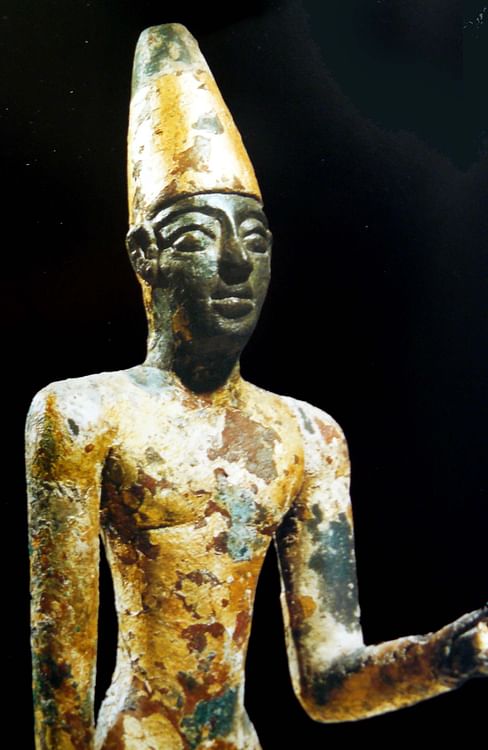
The Phoenician Religion, as in many other ancient cultures, was an inseparable part of everyday life. Gods such as Baal, Astarte, and Melqart had temples built in their name, offerings and sacrifices were regularly made to them, royalty performed as their high priests, and even ships carried their representations. Influenced by their predecessors and neighbours, the Phoenicians would spread their beliefs around the Mediterranean wherever they traded and established colonies, and their religion would continue to evolve and be perpetuated by their greatest colony of all, Carthage.
SOURCES
The details of the mythology, gods, and practices of the religion of the Phoenicians are few and far between because of the scarcity of surviving written records. These are principally from inscriptions excavated at various Phoenician cities as no single religious work such as a Phoenician equivalent of the Bible has survived, if there were ever one in the first place. Secondary sources, written long after the original Phoenician cities had declined, include snippets from Plutarch and Lucian, and surviving fragments of the work of the 1st-century CE historian Philo of Byblos, who himself quoted extensively from an earlier work by the Phoenician priest Sanchuniathon from Berytus. Once thought to be a mythical figure, archaeological excavations at Ugarit suggest that Sanchuniathon did actually exist.
Later historians such as the 5th-century Neo-Platonist Damascius quote the work of Mochus who wrote a history of Phoeniciabut the original is now lost. There are also descriptions of the religious practices in the colonies of Phoenicia such as Carthage but these may well have absorbed local traditions and evolved over time so that a direct comparison with the original cities of Phoenicia may be problematic. Finally, there are passages within the Old Testament in which the Phoenicians are referred to as the Canaanites, where they are portrayed in a particularly negative light, as they are in Roman sources eager to portray the defeated Carthaginians and their Phoenician founders as wholly uncivilized and debauched.
THE GOD MELQART REPRESENTED THE MONARCHY, THE SEA, HUNTING, AND COLONIZATION.
MAIN PHOENICIAN GODS
Although the historical sources present some difficulties of interpretation, the Phoenician Religion was remarkably constant, almost certainly due to the geography of the region where the Phoenicians were contained on the narrow coast of the Levantand backed by the mountains creating a border with their Aramaean and Hebrew neighbours. This is not to say it was uniform throughout the region as ancient Phoenicia was very much a collection of individual city -states rather than a single homogenous state. Each city had its chief god and pantheon for example, although some, such as Astarte, were worshipped throughout Phoenicia. The mythology of the origin of the world from the union of the primeval elements of Wind and Desire, followed by creatures hatched from an egg, which in turn generate humanity, also seems a common element in various cities' creation mythology. Beyond the big three cities of Byblos, Sidon, and Tyre, however, little is known of the religious practices at other Phoenician cities.
BYBLOS
El, Baalat, and Adonis were particularly worshipped at Byblos. El was of Semitic origin and, although equated with Eliun in the Bible, was a separate deity. He was important but not especially active in the daily life of the Phoenicians which led the Greeks to equate him with their Cronus. Baalat was a female deity associated with the earth and fertility. She is often referred to as Baalat Gebal or 'Lady Baalat of Byblos' and frequently mentioned in inscriptions where she is appealed to by kings so that their reign may be a successful one. Altars and monuments constructed from precious metals were dedicated to her. Her equivalents in other Near Eastern cultures were Ishtar, Innin, and Isis. Adonis is familiar from Greek mythology, and he represented for the Phoenicians the annual cycle of nature. Again he shares some characteristics with deities from neighbouring cultures, notably Osiris in Egypt and Tammuz of Babylon and Assyria.
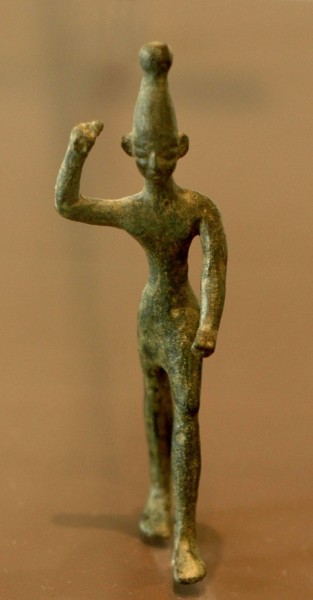
Baal Statue
SIDON
The most important god at Sidon was Baal, probably equivalent in function to El of Byblos, he was head of the pantheon but detached from everyday worship. The city did, though, have at least one temple dedicated to him. Much more prominent was Astarte (in Semitic inscriptions Ashtart and in the Bible Ashtoret) who had many temples dedicated to her and was the equivalent of Baalat at Byblos. The kings of Sidon were referred to as the priests of Astarte, and she frequently appears in surviving Phoenician inscriptions. In art she is often depicted with a crescent on her head, a reference to her close association with the moon. A third important god at Sidon was Eshmun, who does not appear before the 7th century BCE and was the equivalent of Adonis. Temples were built in his name and he was associated with healing, hence the Greeks identified him as their Asclepius.
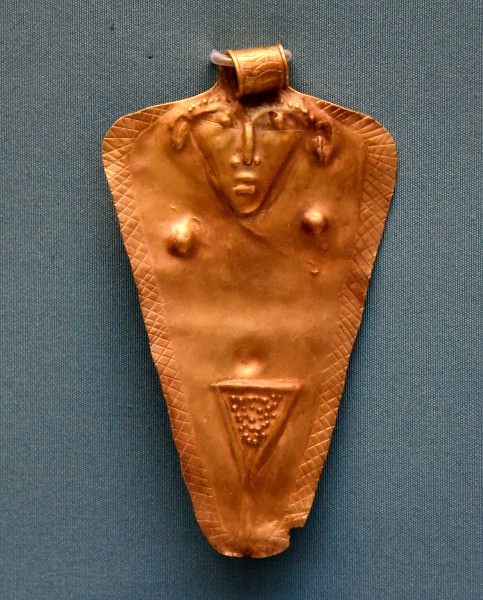
Gold Plaque From Tell el-Ajjul
TYRE
The highest god at Tyre was Melqart (also spelt Melkarth), equivalent to Baal at Sidon and probably confused with him in several passages of the Bible. Melqart, in addition, assumed some of the characteristics of both Adonis and Eshmun as he was the focus of a festival of resurrection each year (February-March). He was considered to represent the monarchy, the sea, hunting, and colonization. Further, he was responsible for the cities commercial success as the discoverer of the dye the Phoenicians extracted from the murex shellfish, which they used to create their famous purple cloth.
A long-lasting temple was dedicated to Melqart in the city and was famously visited by Herodotus, who described its entrance columns of gold and emeralds, and Alexander the Great, who made a sacrifice at its altar. The god was depicted on coins from Tyre in his guise as a sea god riding a hippocampus. Melqart was exported to many Phoenician colonies around the Mediterranean and was especially worshipped at Carthage, which sent annual tribute to the temple of Melqart at Tyre for the next few centuries. The Greeks identified him with Hercules. The other important deity at Tyre was Astarte, who also had her own temple, built by King Hiram in the 10th century BCE.
OTHER GODS
Besides those gods already mentioned the Phoenicians also worshipped Reshef, the god of fire and lightning; Dagon, the god of wheat, who was credited with inventing the plough; and Shadrapa, who was associated with snakes and healing. The god Chusor was thought to have invented iron and metalwork, and several deities were personifications of ideals, such as Sydyk and Misor, who represented Justice and Righteousness, respectively. Other gods were worshipped besides these, although fewer than in most ancient polytheistic religions. For these lesser gods it has become almost impossible to separate them from similar deities from neighbouring cultures, and the misunderstood associations applied by writers living centuries after the Phoenician culture had already been absorbed into the larger Mediterranean world.
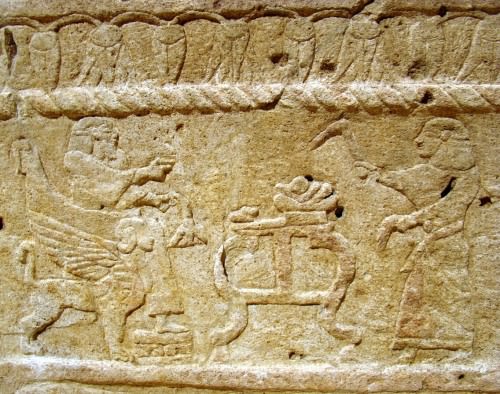
Phoenician Religious Sacrifice
WORSHIP
The Phoenicians worshipped their gods, as we have seen, at purpose-built temples constructed on prominent locations in cities. Although the Phoenicians seem not to have built idols of their gods to place inside their temples as in many other ancient cultures. They also worshipped at natural sites which were considered sacred such as certain mountains, rivers, groves of trees, and even rocks. Rivers carried the names of the gods such as the Adonis River near Byblos and the Asclepius River which ran through Sidon. Here, at these natural sites, small shrines were built but sometimes larger structures too, for example at Aphka, a hill outside Byblos, where an entire sanctuary developed.
Ceremonies at such locations involved prayers, burning incense, the pouring of libations, and making offerings to the gods of animal sacrifices, foodstuffs, and precious goods. In addition, votive columns made from wood ( aserah ) or stone ( betyl ) were placed upon sacrificial altars. These were inscribed with prayers and decorated in festivals with flowers and tree boughs.In the case of Astarte, there was a tradition of women prostituting themselves in her honour. At particular times of danger, for example war or natural disaster, human sacrifices, largely children, were also made as indicated in exaggerated biblical and Roman references, in Phoenician colonies, and in art. Where this rite, in imitation of the sacrifice by El of his own son, was performed is known as a topheth ( tophet ), and the act of sacrifice molk. The victims were killed by fire, although it is not clear precisely how, and there is no archaeological evidence from Phoenicia itself, only its colonies.
The temples and sacred sites were administered by a class of priests and priestesses. It seems likely that the highest class of priests was closely associated with the royal family. Kings and princes may also have themselves performed religious functions. Not only did priests perform in public ceremonies and feasts but they also carried out funeral processes such as embalming. This fact and the presence of votive offerings in rock-cut tombs reveal that the Phoenicians did believe in an after-life. Inscriptions in tombs call for the dead not to be disturbed and that there was an underworld for those who had not led a pious life.
Shapur I › Who Was
Definition and Origins
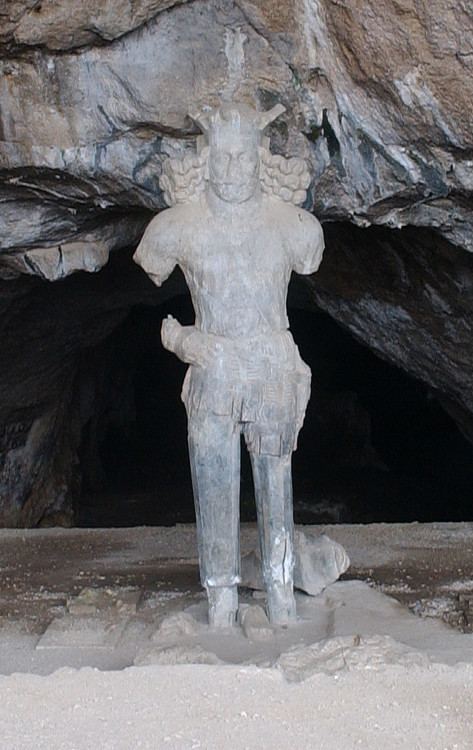
Shapur I (240-270 CE) was the son of Ardashir (224 - c. 241 CE), the founder of the Sasanian dynasty, who made him his co-ruler and brought him on campaigns to learn the art of war. Ardashir was a skilled military leader who not only defeated the Parthian king Artabanus V (c. 208-224 CE) in numerous battles but finally killed him and brought down the Parthian Empire, replacing it with his own. Shapur I learned the lessons his father taught well and used them effectively against his own enemies, most notably Rome.
In the course of his wars with Rome, Shapur I proved himself a clever and unpredictable adversary. He held the distinction of being the first foreign ruler to capture a Roman emperor in battle (the emperor Valerian, 253-260 CE) and was doing well in his war of conquest against Rome until he made an enemy of the Roman governor of Syria, Odaenathus (died c. 267 CE), who defeated him in battle and drove him from Roman territory. After Odaenathus, Shapur I made no further moves against Rome, nor did his son and successor Hormizd I (270 - c. 273 CE) who maintained an uneasy truce with Rome throughout his reign.
Although Shapur I wished to be remembered as a great warrior-king, he had other equally impressive talents. He was a brilliant administrator, instituted policies of religious tolerance, and encouraged the arts and culture. The architectural motif of the domed minaret was developed during his reign and would come to define his building projects and those of the region and culture up to the present day. He was a popular monarch and was honored through inscriptions and, most famously, the Colossal Statue of Shapur I, located in the Shapur Cave in modern-day Iran.
YOUTH & RISE TO POWER
Shapur I had at least two brothers but seems to have been the favorite of his father from an early age. Ardashir was the vassal of the Parthian king Artabanus V who saw him and his family as trouble-makers. Ardashir's father, Papak, had taken control of the district of Istakhr where the ruins of the great Persian city of Persepolis lay. As the former capital of the Persian Empire, Persepolis held great significance for the Parthian Empire which claimed legitimacy for their reign through association with the former glory of the Persians. After Papak's death, Ardashir maintained control of Istakhr in defiance of Artabanus V's authority as king and requests to relinquish the region.
WHEN ARDASHIR DIED C. 241 CE, SHAPUR I ASSUMED THE TRADITIONAL PERSIAN TITLE OF THE MONARCHY, THE KING OF KINGS.
When Artabanus V had tolerated this long enough, he sent the vassal-king of Khuzestan against Ardashir but without success.Artabanus V then met Ardashir in battle personally and was defeated both times; the second time he was killed. Ardashir then founded the Sasanian Dynasty on the ruins of the Parthian Empire. Shapur I was with his father on all of these campaigns.
While Ardashir was consolidating his power, the Parthian king of Armenia, Khosrau I, raised an army to oppose him and formed alliances with a number of powers, including the kingdom of Kushan and Rome. Ardashir did not wait for Khosrau I to launch an attack but mobilized his forces and struck first. The king of Kushan surrendered, and Khosrau I was defeated.Ardashir then sent Shapur I against Rome in Mesopotamia c. 230 CE.
Although the Roman writers claim that Shapur I was defeated in battle by the emperor Alexander Severus, all the Romans really did was halt Shapur I's advance. There is no evidence of a loss of Sasanian territory to the Romans nor any decisive Roman victories of note. Ardashir and Shapur I pressed on and, in the coming years, took a number of important Roman towns and cities. Ardashir was growing tired of rule and warfare and so made Shapur I his co-regent at this time, c. 240 CE;when he died later that year or in early 241 CE, Shapur I assumed the traditional Persian title of the monarchy, the King of Kings.
ADMINISTRATION & RELIGIOUS TOLERANCE
Shapur I and his father were great builders whose palaces and temples showed a number of innovations, such as domed entrances and minarets, which became a staple of later Iranian architecture. They also understood the importance of religious faith in unifying a state and so made their own, Zoroastrianism, the state religion.
Even so, Shapur I also recognized that diversity encouraged vitality and so, from early in his reign, adhered to a policy of religious tolerance, allowing Christians, Jews, and other faiths to practice their religion freely. This atmosphere of tolerance allowed for the development of one of the most influential religious faiths of the ancient world – Manichaeism – whose founder, Mani (216-274 CE), had a place at Shapur I's court. Christians were allowed to build churches and Jews synagogues, even though their teachings were at odds with the state religion and, at times, antagonistic to it.
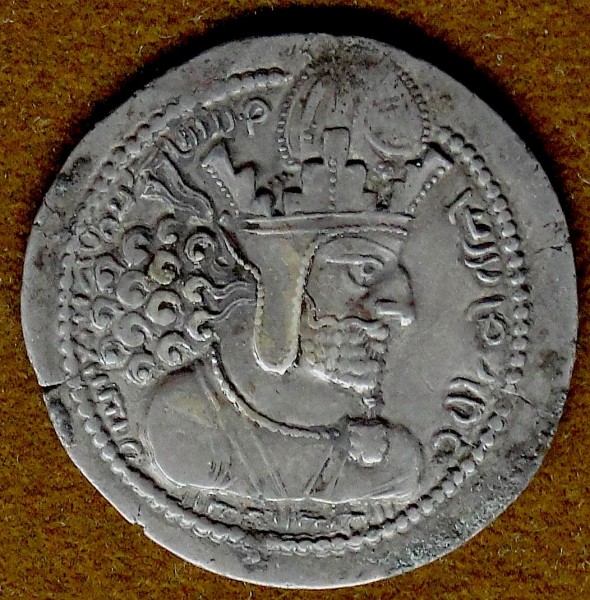
Coin of Shapur I
Zoroastrianism, with its vision of the universe in constant struggle between the forces of good and those of evil, light vs. dark, was perfectly suited to a state whose focus was primarily warfare. Shapur I saw himself as a leader of the forces of light and comported himself accordingly by encouraging the peaceful practice of all religions in his realm and devoting his scribes to the translation and revision of religious and philosophical works. At the same time, along with commissioning the construction of grand building projects, he led his armies against those he saw as the forces of darkness.
WAR WITH ROME
Although Shapur I was an able administrator and ruler whose reign is recorded in glowing phrases by everyone except Roman writers, he thought of himself as a warrior-king first and tried to exemplify this ideal. He took Roman fortresses and cities in Mesopotamia and drove his army on to conquer more territory, greatly enlarging the kingdom he had inherited from his father.
SHAPUR I TOOK FULL ADVANTAGE OF ROME'S CONFUSION TO FURTHER ENLARGE HIS KINGDOM.
He was as skilled in battle as he was in bureaucratic administration and won a number of victories against Rome after Alexander Severus was murdered by his own troops on campaign in Germania in 235 CE. Severus' assassination plunged Rome into the chaotic period known as the Crisis of the Third Century (235-284 CE) during which over 20 emperors would rise and fall in almost 50 years. Shapur I took full advantage of Rome's confusion to further enlarge his kingdom.
Returning to campaign against the Romans in Mesopotamia, he was checked by the emperor Gordian III (238-244 CE), only 17 years old at the time. Gordian III was an inexperienced soldier and statesman who relied heavily on the advice and strategies of his father-in-law and Praetorian Prefect, Gaius Timesitheus, a skilled leader and able commander. Shapur I was defeated by Gordian III's forces initially, but when Timesitheus died of the plague the situation reversed; Gordian III had no natural talents for warfare and no ability to counter Shapur I's strategies. After a number of setbacks for the Roman forces, Gordian III was killed by his own troops, who then replaced him as emperor with a popular commander, Philip the Arab (244-249 CE).
Philip understood he needed to extricate himself from the war with Shapur I to deal with the many other challenges facing Rome. He made peace with Shapur I and paid him 500,000 denars as part of the treaty. According to Shapur I's inscriptions, Philip also agreed to Rome becoming a tributary, but this claim has been challenged. Philip ceded the disputed territory of Armenia to Shapur I but quickly went back on the treaty and reclaimed the region; this action obviously broke the peace and reignited hostilities.
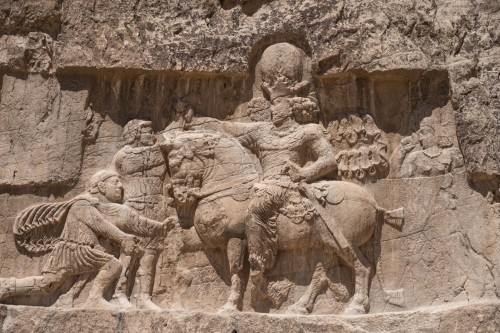
Valerian Defeated by Shapur I
Shapur I again struck at the Romans in Mesopotamia and conquered the Roman province of Syria, taking the city of Antioch.Antioch was one of the most important urban centers of ancient Rome, and its conquest could not go unchallenged. Emperor Valerian marched against Shapur I and drove him from the city, but the plague then struck the Roman army and they were forced to retreat back behind the walls of Antioch.
Shapur I lay siege to the city, and Valerian was forced to seek terms of surrender. He and his senior staff went out to meet Shapur I, expecting to be treated according to the rules of engagement they were used to but were instead taken captive.Shapur I did not consider the “forces of darkness” worthy of negotiation. The Sasanid army then intensified the siege of the city, under the direction of Shapur I's son Hormizd I, and Antioch fell. According to legend, Shapur I used Valerian as a footstool he had brought out each time he wanted to mount his horse, and when the emperor died, he had his body stuffed with straw and put on display in the palace for visiting dignitaries.
SHAPUR I & ODAENATHUS
Rome was in an almost constant state of chaos at this time as one emperor after another proved disappointing to his troops, the Senate, the people, or all three, and was executed in favor of another military commander. During the Crisis of the Third Century, elevating a man to the supreme position of emperor of Rome was almost a death sentence, but this did not prevent ambitious men from continually vying for the throne.
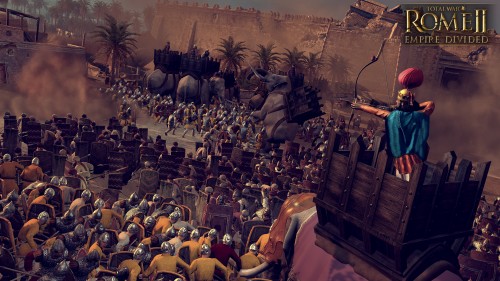
Hormizd I in Battle
On the eastern border of the Roman Empire, the city of Palmyra in Syria was governed by a man named Odaenathus who seems to have considered Shapur I a better bet to advance his fortunes than any of the emperors of Rome. He sent Shapur I an offer of alliance, which was rebuffed. Shapur I replied that Odaenathus was not his equal and, far from thinking they could be allies, the Roman governor should look forward to becoming Shapur I's vassal.
Odaenathus was insulted and, claiming he was mobilizing his forces to free Valerian from the Sasanids, marched against Shapur I. He had at his command a troop of Bedouin soldiers, who knew the land as well as the Sasanid army, and his own Syrian troops were fully acclimated to the climate of the region, unlike those under Gordian III or Valerian who had been deployed from Rome. Odaenathus defeated Shapur I and drove him and his army from the Roman territories.
Shapur I's victory over Valerian was among his last. Regarding Odaenathus' campaigns, scholar Philip Matyszak notes how Shapur I “discovered that a well-led Roman army was still the world's finest fighting force” (239). Shapur I quickly lost any gains he had made and retreated back to his own borders. Odaenathus was rewarded for his services to Rome by elevation in rank to governor of the entire province of Syria. When he was killed on a hunting trip c. 267 CE, rule would pass to his young son but power would be wielded by his wife Zenobia (267-272 CE) who would found the Palmyrene Empire.
CONCLUSION

Colossal Statue of Shapur I
The statue is an intricately carved piece, which was decorated in antiquity with jewels and was so carefully created that, even in its present ruinous state, the image of the great king remains impressive and gives some idea of the grandeur of his reign.Although he was defeated by the Roman forces under Odaenathus, he maintained his kingdom and continued his policies of justice, religious tolerance, great building projects, and cultural diffusion, handing this legacy on to his son who continued them. His reign is consistently praised by non-Roman scribes for all of these accomplishments, and he continues to be regarded as a King of Kings, with the same level of respect he knew while he lived, up to the present day.
See other Related Contents ››
LICENSE:
Article based on information obtained from these sources:with permission from the Website Ancient History Encyclopedia
Content is available under License Creative Commons: Attribution-NonCommercial-ShareAlike 3.0 Unported. CC-BY-NC-SA License